Hungry? Thirsty?
If you don’t prep in advance – you will be!
Grab these titles before you need them. Your belly will thank you.
Food
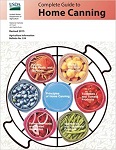 Complete Guide to Home Canning (USDA) (PDF) – The first part of this publication explains the scientific principles on which canning techniques are based, discusses canning equipment, and describes the proper use of jars and lids. It describes basic canning ingredients and procedures and how to use them to achieve safe, high-quality canned products. Finally, it helps you decide whether or not and how much to can.The second part of this publication is a series of canning guides for specific foods. These guides offer detailed directions for making sugar syrups; and for canning fruits and fruit products, tomatoes and tomato products, vegetables, red meats, poultry, seafoods, and pickles and relishes. Handy guidelines for choosing the right quantities and quality of raw foods accompany each set of directions for fruits, tomatoes, and vegetables. Most recipes are designed to yield a full canner load of pints or quarts. Finally, processing adjustments for altitudes above sea level are given for each food.This publication contains many new research-based recommendations for canning safer and better quality food at home. It is an invaluable resource book for persons who are canning food for the first time. Experienced canners will find updated information to help them improve their canning practices.
Complete Guide to Home Canning (USDA) (PDF) – The first part of this publication explains the scientific principles on which canning techniques are based, discusses canning equipment, and describes the proper use of jars and lids. It describes basic canning ingredients and procedures and how to use them to achieve safe, high-quality canned products. Finally, it helps you decide whether or not and how much to can.The second part of this publication is a series of canning guides for specific foods. These guides offer detailed directions for making sugar syrups; and for canning fruits and fruit products, tomatoes and tomato products, vegetables, red meats, poultry, seafoods, and pickles and relishes. Handy guidelines for choosing the right quantities and quality of raw foods accompany each set of directions for fruits, tomatoes, and vegetables. Most recipes are designed to yield a full canner load of pints or quarts. Finally, processing adjustments for altitudes above sea level are given for each food.This publication contains many new research-based recommendations for canning safer and better quality food at home. It is an invaluable resource book for persons who are canning food for the first time. Experienced canners will find updated information to help them improve their canning practices.
Don’t rely on store-bought canned goods. With this book you can get a zucchini in your own can!
 Food Storage for Self-Sufficiency and Survival: The Essential Guide for Family Preparedness – This in-depth, nuts-and-bolts guide to storing food teaches you a variety of food storage methods that you can customize to meet your family’s unique circumstances including family size, tastes, ages, health concerns, income, and living conditions. This is not a generic manual on stocking dehydrated meals that have ten-year shelf lives. It’s the guide to storing foods your family loves so you can eat well no matter what challenges life throws at you. Storing food gives you the freedom to stretch your income in tight-budget months, pack quick meals for short-notice trips, and create healthy meals without constantly going to the grocery store. Plus your stored food is available if you do experience an emergency power outage, natural disaster, long-term illness or job loss. Let this guide help you start building your self-sufficiency and food storage today.
Food Storage for Self-Sufficiency and Survival: The Essential Guide for Family Preparedness – This in-depth, nuts-and-bolts guide to storing food teaches you a variety of food storage methods that you can customize to meet your family’s unique circumstances including family size, tastes, ages, health concerns, income, and living conditions. This is not a generic manual on stocking dehydrated meals that have ten-year shelf lives. It’s the guide to storing foods your family loves so you can eat well no matter what challenges life throws at you. Storing food gives you the freedom to stretch your income in tight-budget months, pack quick meals for short-notice trips, and create healthy meals without constantly going to the grocery store. Plus your stored food is available if you do experience an emergency power outage, natural disaster, long-term illness or job loss. Let this guide help you start building your self-sufficiency and food storage today.
If self-sufficiency is freedom, and freedom is not free, then buying this book is the path to freedom.
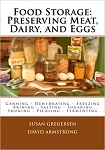 Food Storage: Preserving Meat, Dairy, and Eggs – The book is divided into two sections. Part one is an explanation of all the preserving methods, how to do them, and what you’ll need: Canning, Dehydrating, Freezing, Salting, Brining, Sugaring, Smoking, Pickling, and Fermenting, as well as some not-as-often heard of ones as Ash, Oil, and Honey for preservation. Part two begins with meat and works it’s way through beef/venison/elk, pork/bear, goat/sheep, rabbit, chicken, turkey, duck/goose, and fish; then dairy: milk, butter, cheeses, yogurt and sour cream, and finishes with a chapter on preserving eggs. All the methods that work well with each food are explained along with directions for the preparation and processing of that food. There is also information about what doesn’t work and why.
Food Storage: Preserving Meat, Dairy, and Eggs – The book is divided into two sections. Part one is an explanation of all the preserving methods, how to do them, and what you’ll need: Canning, Dehydrating, Freezing, Salting, Brining, Sugaring, Smoking, Pickling, and Fermenting, as well as some not-as-often heard of ones as Ash, Oil, and Honey for preservation. Part two begins with meat and works it’s way through beef/venison/elk, pork/bear, goat/sheep, rabbit, chicken, turkey, duck/goose, and fish; then dairy: milk, butter, cheeses, yogurt and sour cream, and finishes with a chapter on preserving eggs. All the methods that work well with each food are explained along with directions for the preparation and processing of that food. There is also information about what doesn’t work and why.
Not for vegans! Of course, there won’t be any vegans after the mushroom cloud goes up. If it moves – it can be eaten!
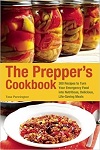 Prepper’s Cookbook: 300 Recipes to Turn Your Emergency Food into Nutritious, Delicious, Life-Saving Meals – When a catastrophic collapse cripples society, grocery store shelves will empty within days. But if you follow this book’s plan for stocking, organizing and maintaining a proper emergency food supply, your family will have plenty to eat for weeks, months or even years. Packed with tips for off-grid cooking, canning charts for over 20 fruits and vegetables, and checklists for the best emergency pantry items, The Prepper’s Cookbook will have you turning shelf-stable, freeze-dried and dehydrated foods into delicious, nutritious dishes your family will love eating.
Prepper’s Cookbook: 300 Recipes to Turn Your Emergency Food into Nutritious, Delicious, Life-Saving Meals – When a catastrophic collapse cripples society, grocery store shelves will empty within days. But if you follow this book’s plan for stocking, organizing and maintaining a proper emergency food supply, your family will have plenty to eat for weeks, months or even years. Packed with tips for off-grid cooking, canning charts for over 20 fruits and vegetables, and checklists for the best emergency pantry items, The Prepper’s Cookbook will have you turning shelf-stable, freeze-dried and dehydrated foods into delicious, nutritious dishes your family will love eating.
This is the mother of all prepper cookbooks, but it’s not your mother’s cookbook, you should buy it for her.
Water

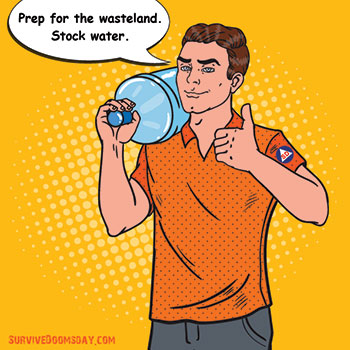 Complete Guide to Water Storage: How to Use Gray Water and Rainwater Systems, Rain Barrels, Tanks, and Other Water Storage Techniques for Household and Emergency Use – This book will guide you through the process of learning more about these potential lifesaving water storage methods, the legal implications, and the financial aspects of storing your own water for future. There are numerous ways you can store water for emergency or future use; this book will help you learn everything you need to start taking advantage of those methods according to the space you have and the time and money you can invest. You will learn all of the basic design principles of water storage as well as how water quality is measured and maintained while in storage. You will learn the various ways to store water, from soil to direct to aquifers, ponds, open tanks, swimming pools, and tanks. You will learn the various types of water tank design for each method of storage and what each one involves and requires.
Complete Guide to Water Storage: How to Use Gray Water and Rainwater Systems, Rain Barrels, Tanks, and Other Water Storage Techniques for Household and Emergency Use – This book will guide you through the process of learning more about these potential lifesaving water storage methods, the legal implications, and the financial aspects of storing your own water for future. There are numerous ways you can store water for emergency or future use; this book will help you learn everything you need to start taking advantage of those methods according to the space you have and the time and money you can invest. You will learn all of the basic design principles of water storage as well as how water quality is measured and maintained while in storage. You will learn the various ways to store water, from soil to direct to aquifers, ponds, open tanks, swimming pools, and tanks. You will learn the various types of water tank design for each method of storage and what each one involves and requires.
Beyond just drinking, you need water to re-hydrate freeze dried foods (and to make beer).
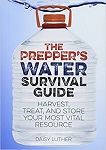 Prepper’s Water Survival Guide: Harvest, Treat, and Store Your Most Vital Resource – You can survive up to three weeks without food, but only three days without water! When catastrophe strikes, having enough water can spell the difference between life and death. The Prepper’s Water Survival Guide offers a step-by-step plan with straightforward information you can easily follow. Thanks to this book’s laser-focus on water, you’ll quickly learn how to: 1) store fresh water; 2) collect rainwater; 3) purify water from lakes & rivers, and 4) dig a well for groundwater. In addition to harvesting water, you’ll gain the tools to keep large stores untainted for long periods of time, test the water you collect for dangerous toxins, and treat water-related illnesses that are commonly contracted during a disaster.
Prepper’s Water Survival Guide: Harvest, Treat, and Store Your Most Vital Resource – You can survive up to three weeks without food, but only three days without water! When catastrophe strikes, having enough water can spell the difference between life and death. The Prepper’s Water Survival Guide offers a step-by-step plan with straightforward information you can easily follow. Thanks to this book’s laser-focus on water, you’ll quickly learn how to: 1) store fresh water; 2) collect rainwater; 3) purify water from lakes & rivers, and 4) dig a well for groundwater. In addition to harvesting water, you’ll gain the tools to keep large stores untainted for long periods of time, test the water you collect for dangerous toxins, and treat water-related illnesses that are commonly contracted during a disaster.
Use the water stored via information in the first book for drinking. Use the water harvested via information in this book for washing up (and for making beer).